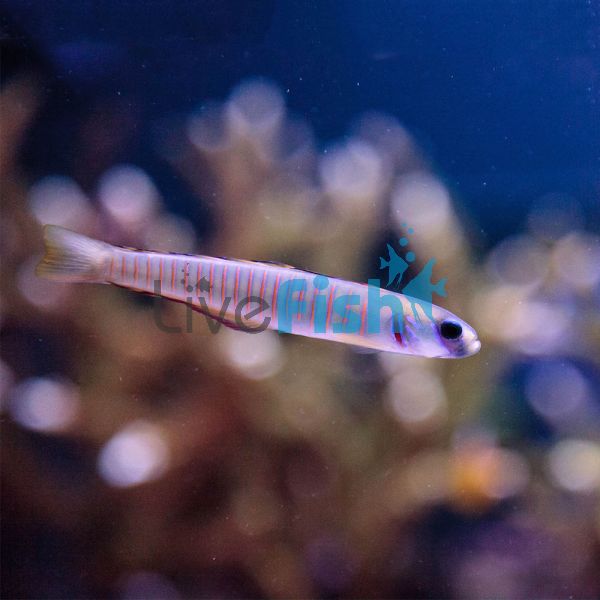Zebra Dartfish - Medium
A school of Zebra Dartfish will provide plenty of activity and encourage some of your shyer reef inhabitants to become more social. These delightful unusual fish are rarely seen in aquariums, mainly because many hobbyists are unaware of their existence.
The Zebra Dartfish has a long, slender body that is usually green to grey with evenly spaced vertical pinkish-orange bars running down it. These bars form an impressive and intricate pattern. Blue hints can be seen around the eyes, gill cover, and dorsal fin.
The Zebra Dartfish is a hardy and peaceful species that can reach a maximum length of 4" (10cm). Their small size doesn't however make them suitable for Nano aquarium setups, as they require plenty of swimming space. They are well suited for community reef aquariums due to their peaceful temprament.
They are also an excellent schooling fish, but keeping a school of them necessitates larger aquariums.
Once adjusted to the aquarium, they are very peaceful and are constantly found in the water column. They are reef safe and have unique colouration that is difficult to capture in photographs.
Zebra dartfish are commonly found in groups among the tropical reefs of the Indo-Pacific. Zebra Dartfish, like other Dartfish species, feeds primarily on planktonic life in the water column as well as among the reef and substrate rubble.
The Zebra Dartfish can be found throughout the Indo-Pacific region, from the Red Sea to the Marquesan Islands, and from Japan's Ryukyu Islands to the Great Barrier Reef.
Tank Recommendations for Zebra Dartfish
Despite its small size, the Zebra Dartfish is a very active fish that should be kept in a 48-inch (122cm) long tank to allow for the minimum amount of open swimming space that they require. You'll also need some hiding places for these fish to go to when they're feeling stressed or threatened. These fish prefer a lot of small hiding spots in your live rock throughout the aquarium. Zebra Dartfish requires a tank with a closed top because they have been known to jump out of open-top tanks frequently.
Zebra Dartfish requires at least 30 gallons (114 litre) of aquarium space, as well as plenty of live rock and open swimming space. They should be given a live sand substrate capable of supporting a population of amphipods, copepods, and other planktonic life (a refugium is also beneficial, but not required). They are mostly seen swimming around the middle levels of the aquarium, and they frequently return to their favourite spots. Zebra Dartfish should be kept in groups of 2-5 because they prefer the company of their conspecifics. They will also get along well with other peaceful fish. They should not be kept with aggressive species that may harass them.
Suitable Tank Buddies
The Zebra Dartfish is an excellent community fish. They are very peaceful and do not endanger the reef. They are very active and fast swimmers. For this reason they should be kept with other fish that will not be frightened by their high activity level and fast movements. Keeping them in a school of 2-5 is the minimum recommended, but they seem to do better in groups of 8 or more. They work well as dither fish, potentially making other fish feel more at ease by allowing them to see other fish swimming around in the aquarium.
Usually Compatible
Zebra Dartfish is quite peaceful and are completely safe with other peaceful fish, coral species, and ornamental invertebrates. Zebra Dartfish is a popular choice for beginners as they are easy to care for.
Sometime Compatible
These fish should not be housed with overly aggressive tank mates that may pick on them. In the absence of huge fish, such as adult angelfish or surgeonfish, they will thrive. The presence of larger fish will not doom the Zebra Dartfish, but it will make them work harder to find adequate food. It will also likely prevent natural shoaling, as the Zebra Dartfish will prefer to stay closer to the rockwork if it feels threatened.
Usually they can be house with Batfish, Butterflyfish, Cardinalfish, Damselfish and Filefish. Watch them if being housed with Grunts, Rays, Squirrelfish or Triggerfish.
Rarely Compatible
Because Zebra Dartfish can be easy prey, predatory fish and predatory invertebrates, such as the Ophiarachna species of starfish, should be avoided when choosing tankmates. So Sharks, Scorpionfish, Groupers, Eels, and Lionfish, should all be avoided as they will view them as a meal.
Feeding your Zebra Dartfish
Zebra Dartfish are carnivores that can be found in their natural habitat patrolling the water column and reefs for planktonic life. Where they will eat amphipods, copepods, tiny crustaceans, various larvae, and other zooplankton. They should be fed a variety of live, frozen, freeze-dried foods. Vitamin-enriched brine shrimp, live rotifers and copepods, mysis shrimp, krill, and prepared marine food items should be offered. They will also accept high-quality flake foods to supplement a varied diet. Feed your fish once or twice a day.
| Scientific Name | Ptereleotris zebra |
|---|---|
| Care Level | Easy |
| Common Names | Zebra Barred Dartfish, Zebra Dart Goby, Bar Goby, Barred Dartfish, Zebra Goby, and Chinese Zebra Goby |
| Diet | Carnivore |
| Fish Family | Microdesmidae |
| Lifespan (years) | 8 |
| Max. Length (cm) | 10 |
| Min. Tank Volume (l) | 114 |
| Origin | Fiji, Indonesia, Maldives |
| Reef Safe | Yes |
| Sociability | Peaceful |
| Venomous | No |
| Water Conditions | SG 1.020-1.025, 72º-78º F, dKH 8-12, pH 8.1-8.4 |




